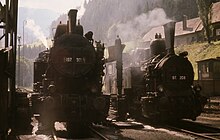Giesl ejector
A Giesl ejector is an induced draft system for steam locomotives that works on the jet pump principle .
How a Giesl ejector suction system works
Steam locomotives require a constructive measure that causes combustion gases to be drawn from the coal combustion chamber through long, thin boiler pipes to the chimney and expelled there. For this purpose, steam is blown into the exhaust gas flow under the chimney - also known as the exhaust. The jet pump principle creates the required negative pressure when the steam is released in the chimney. The design of the injection nozzle, its control and the shape of the exhaust have a great influence on the performance of the steam engine, because the counter pressure in the cylinder should be as small as possible. The “Giesl ejector” is such a system with particularly low back pressure. Locomotives equipped with a Giesl ejector can be easily recognized by the special narrow shape of the chimney.
history
The ejector - often called the flat chimney or disparagingly squeeze chamber because of its external appearance - was developed in 1951 by Adolph Giesl-Gieslingen . The Giesl ejector causes improved induced draft and thus better energy utilization. The previous blowpipe is formed by a blowpipe head with several blowpipe nozzles lying one behind the other, the cones of which slightly overlap. This gives the diffuser its flat, elongated shape. A typical design of the ejector is made up of seven blow pipe nozzles standing in a row with an almost square cross-section.
Giesl promised 6 to 12% coal savings through the Giesl ejector, which in practice was more like a maximum of 8%, and an increase in output of up to 20%. Steam locomotives of many railways were converted with Giesl ejectors, among others at ÖBB , ČSD and DR , but also at railway administrations in Africa , China and Japan . Not in all cases were the royalties paid, which it was said would often almost offset the coal savings. At the DR, the Giesl ejectors are said to have amortized after just one year, which is why over 500 locomotives were converted there, mainly the 38.10 , 50 , 52 , 65.10 and 78 series . The best-known single piece with a Giesl ejector is the high-speed test locomotive 18 201 .
Apparently, the German Federal Railroad was far less convinced of the increase in evaporation capacity and improved economic efficiency through the Giesl ejector than the DR at that time.
In 2020, 52 8141 of the OSEF Löbau was equipped with a Giesl flat ejector as part of a general inspection at the Meiningen steam locomotive works. At this time it was the only operational steam locomotive in Germany with such an induced draft system.
literature
- Josef Otto Slezak: The Giesl ejector - rejuvenation for steam locomotives. (International Archive for Locomotive History Issue 7). Slezak-Verlag, Vienna 1967, DNB 364636637 .
- Andreas Knipping: Luckless Giesl. In: Railway courier. 8 (2012), pp. 64-68 (part 1); Railway courier. 9 (2012), pp. 64-68 (part 2) ISSN 0170-5288 .
- Rainer Humbach: Giesl locomotives all over the world. In: Railway courier. 10 (2012), pp. 63-66 ISSN 0170-5288 .
- Rudolf Heym: How does it actually work, the steam locomotive? Geramond, Munich 2004, ISBN 3-7654-7255-7 .
See also
- Kylchap suction system
Web links
Individual evidence
- ↑ lokmalanders.de der Giesl-Ejektor http://www.lokmalanders.de/media/389b5b9e54ca9af0ffff8024fffffff1.pdf accessed on May 1, 2016
- ^ Adolph Giesl-Gieslingen: Anatomy of the steam locomotive. Slezak-Verlag, Vienna 1986, ISBN 3-85416-089-5 .

